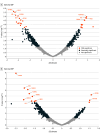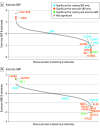Plasma Proteomics of Exercise Blood Pressure and Incident Hypertension
- PMID: 38865108
- PMCID: PMC11170454
- DOI: 10.1001/jamacardio.2024.1397
Plasma Proteomics of Exercise Blood Pressure and Incident Hypertension
Erratum in
-
Error in Figure.JAMA Cardiol. 2024 Aug 1;9(8):760. doi: 10.1001/jamacardio.2024.2323. JAMA Cardiol. 2024. PMID: 39141066 Free PMC article. No abstract available.
Abstract
Importance: Blood pressure response during acute exercise (exercise blood pressure [EBP]) is associated with the future risk of hypertension and cardiovascular disease (CVD). Biochemical characterization of EBP could inform disease biology and identify novel biomarkers of future hypertension.
Objective: To identify protein markers associated with EBP and test their association with incident hypertension.
Design, setting, and participants: This study assayed 4977 plasma proteins in 681 healthy participants (from 763 assessed) of the Health, Risk Factors, Exercise Training and Genetics (HERITAGE; data collection from January 1993 to December 1997 and plasma proteomics from January 2019 to January 2020) Family Study at rest who underwent 2 cardiopulmonary exercise tests. Individuals were free of CVD at the time of recruitment. Individuals with resting SBP ≥160 mm Hg or DBP ≥100 mm Hg or taking antihypertensive drug therapy were excluded from the study. The association between resting plasma protein levels to both resting BP and EBP was evaluated. Proteins associated with EBP were analyzed for their association with incident hypertension in the Framingham Heart Study (FHS; n = 1177) and validated in the Jackson Heart Study (JHS; n = 772) and Multi-Ethnic Study of Atherosclerosis (MESA; n = 1367). Proteins associated with incident hypertension were tested for putative causal links in approximately 700 000 individuals using cis-protein quantitative loci mendelian randomization (cis-MR). Data were analyzed from January 2023 to January 2024.
Exposures: Plasma proteins.
Main outcomes and measures: EBP was defined as the BP response during a fixed workload (50 W) on a cycle ergometer. Hypertension was defined as BP ≥140/90 mm Hg or taking antihypertensive medication.
Results: Among the 681 participants in the HERITAGE Family Study, the mean (SD) age was 34 (13) years; 366 participants (54%) were female; 238 (35%) were self-reported Black and 443 (65%) were self-reported White. Proteomic profiling of EBP revealed 34 proteins that would not have otherwise been identified through profiling of resting BP alone. Transforming growth factor β receptor 3 (TGFBR3) and prostaglandin D2 synthase (PTGDS) had the strongest association with exercise systolic BP (SBP) and diastolic BP (DBP), respectively (TGFBR3: exercise SBP, β estimate, -3.39; 95% CI, -4.79 to -2.00; P = 2.33 × 10-6; PTGDS: exercise DBP β estimate, -2.50; 95% CI, -3.29 to -1.70; P = 1.18 × 10-9). In fully adjusted models, TGFBR3 was inversely associated with incident hypertension in FHS, JHS, and MESA (hazard ratio [HR]: FHS, 0.86; 95% CI, 0.75-0.97; P = .01; JHS, 0.87; 95% CI, 0.77-0.97; P = .02; MESA, 0.84; 95% CI, 0.71-0.98; P = .03; pooled cohort, 0.86; 95% CI, 0.79-0.92; P = 6 × 10-5). Using cis-MR, genetically predicted levels of TGFBR3 were associated with SBP, hypertension, and CVD events (SBP: β, -0.38; 95% CI, -0.64 to -0.11; P = .006; hypertension: odds ratio [OR], 0.99; 95% CI, 0.98-0.99; P < .001; heart failure with hypertension: OR, 0.86; 95% CI, 0.77-0.97; P = .01; CVD: OR, 0.84; 95% CI, 0.77-0.92; P = 8 × 10-5; cerebrovascular events: OR, 0.77; 95% CI, 0.70-0.85; P = 5 × 10-7).
Conclusions and relevance: Plasma proteomic profiling of EBP identified a novel protein, TGFBR3, which may protect against elevated BP and long-term CVD outcomes.
Conflict of interest statement
Figures




References
MeSH terms
Substances
Grants and funding
LinkOut - more resources
Full Text Sources
Medical
Miscellaneous

